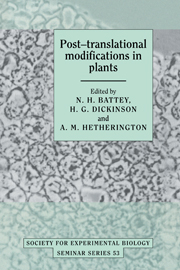Book contents
- Frontmatter
- Contents
- List of contributors
- List of abbreviations
- Preface
- Some roles of post-translational modifications in plants
- Signal transduction and protein phosphorylation in bacteria
- Roles of protein phosphorylation in animal cells
- The significance of post-translational modification of proteins by phosphorylation in the regulation of plant development and metabolism
- Post-translational modification of chloroplast proteins and the regulation of protein turnover
- Purification of a small phosphoprotein from chloroplasts and characterisation of its phosphoryl group
- Use of synthetic peptides to study G proteins and protein kinases within plant cells
- Activation of membrane-associated protein kinase by lipids, its substrates, and its function in signal transduction
- Distribution and function of Ca2+-dependent, calmodulin-independent protein kinases
- Phosphorylation of the plasma membrane proton pump
- The regulation of phosphoenolpyruvate carboxylase by reversible phosphorylation
- Protein phosphorylation and circadian rhythms
- Control of translation by phosphorylation of mRNP proteins in Fucus and Xenopus
- Regulation of plant metabolism by reversible protein (serine/threonine) phosphorylation
- Detection, biosynthesis and some functions of glycans N-linked to plant secreted proteins
- Biosynthesis, intracellular transport and processing of ricin
- Post-translational processing of concanavalin A
- The role of cell surface glycoproteins in differentiation and morphogenesis
- Ubiquitination of proteins during floral development and senescence
- Index
Some roles of post-translational modifications in plants
Published online by Cambridge University Press: 06 July 2010
- Frontmatter
- Contents
- List of contributors
- List of abbreviations
- Preface
- Some roles of post-translational modifications in plants
- Signal transduction and protein phosphorylation in bacteria
- Roles of protein phosphorylation in animal cells
- The significance of post-translational modification of proteins by phosphorylation in the regulation of plant development and metabolism
- Post-translational modification of chloroplast proteins and the regulation of protein turnover
- Purification of a small phosphoprotein from chloroplasts and characterisation of its phosphoryl group
- Use of synthetic peptides to study G proteins and protein kinases within plant cells
- Activation of membrane-associated protein kinase by lipids, its substrates, and its function in signal transduction
- Distribution and function of Ca2+-dependent, calmodulin-independent protein kinases
- Phosphorylation of the plasma membrane proton pump
- The regulation of phosphoenolpyruvate carboxylase by reversible phosphorylation
- Protein phosphorylation and circadian rhythms
- Control of translation by phosphorylation of mRNP proteins in Fucus and Xenopus
- Regulation of plant metabolism by reversible protein (serine/threonine) phosphorylation
- Detection, biosynthesis and some functions of glycans N-linked to plant secreted proteins
- Biosynthesis, intracellular transport and processing of ricin
- Post-translational processing of concanavalin A
- The role of cell surface glycoproteins in differentiation and morphogenesis
- Ubiquitination of proteins during floral development and senescence
- Index
Summary
Phosphorylation
Receptors and signal transduction
The first stage in an idealised signal transduction chain is binding of the ligand (hormone or other effector molecule) to its receptor. In animal cells phosphorylation on tyrosine residues has been shown to be an important consequence of ligand binding in many transmembrane receptors (for example for insulin, platelet-derived growth factor, epidermal growth factor); other receptor types, operating via the G protein/phospholipase C or adenylate cyclase routes, have their receptor activity modulated by phosphorylation (for example the β2-adrenergic receptor). A useful summary of the roles of phosphorylation in these and other animal systems is given by Hardie (this volume).
In plants, receptors for growth regulators have been characterised to varying degrees (Napier & Venis, 1990); however, there is no evidence for a role for phosphorylation in either their regulation or their transduction mechanisms. The only evidence for a transmembrane receptor protein kinase comes from maize, in which a cDNA clone encoding a putative serine/threonine kinase structurally related to receptor tyrosine kinases has been described (Walker & Zhang, 1990). The extracellular domain of this protein is similar to that of Brassica S-locus glycoproteins involved in the self-incompatibility mechanism of this genus (see section on glycosylation, below). The structural similarity to tyrosine kinases like the epidermal growth factor receptor suggests that the extracellular domain of the maize protein interacts with a ligand and that this activates the kinase domain on the cytoplasmic side.
- Type
- Chapter
- Information
- Post-translational Modifications in Plants , pp. 1 - 16Publisher: Cambridge University PressPrint publication year: 1993
- 2
- Cited by



